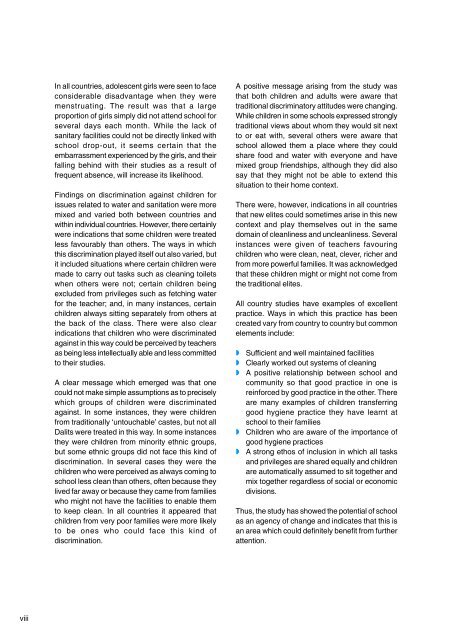Equity in School Water and Sanitation
Equity in School Water and Sanitation
Equity in School Water and Sanitation
Create successful ePaper yourself
Turn your PDF publications into a flip-book with our unique Google optimized e-Paper software.
EQUITY IN SCHOOL WATER AND SANITATIONIn all countries, adolescent girls were seen to faceconsiderable disadvantage when they weremenstruat<strong>in</strong>g. The result was that a largeproportion of girls simply did not attend school forseveral days each month. While the lack ofsanitary facilities could not be directly l<strong>in</strong>ked withschool drop-out, it seems certa<strong>in</strong> that theembarrassment experienced by the girls, <strong>and</strong> theirfall<strong>in</strong>g beh<strong>in</strong>d with their studies as a result offrequent absence, will <strong>in</strong>crease its likelihood.F<strong>in</strong>d<strong>in</strong>gs on discrim<strong>in</strong>ation aga<strong>in</strong>st children forissues related to water <strong>and</strong> sanitation were moremixed <strong>and</strong> varied both between countries <strong>and</strong>with<strong>in</strong> <strong>in</strong>dividual countries. However, there certa<strong>in</strong>lywere <strong>in</strong>dications that some children were treatedless favourably than others. The ways <strong>in</strong> whichthis discrim<strong>in</strong>ation played itself out also varied, butit <strong>in</strong>cluded situations where certa<strong>in</strong> children weremade to carry out tasks such as clean<strong>in</strong>g toiletswhen others were not; certa<strong>in</strong> children be<strong>in</strong>gexcluded from privileges such as fetch<strong>in</strong>g waterfor the teacher; <strong>and</strong>, <strong>in</strong> many <strong>in</strong>stances, certa<strong>in</strong>children always sitt<strong>in</strong>g separately from others atthe back of the class. There were also clear<strong>in</strong>dications that children who were discrim<strong>in</strong>atedaga<strong>in</strong>st <strong>in</strong> this way could be perceived by teachersas be<strong>in</strong>g less <strong>in</strong>tellectually able <strong>and</strong> less committedto their studies.A clear message which emerged was that onecould not make simple assumptions as to preciselywhich groups of children were discrim<strong>in</strong>atedaga<strong>in</strong>st. In some <strong>in</strong>stances, they were childrenfrom traditionally ‘untouchable’ castes, but not allDalits were treated <strong>in</strong> this way. In some <strong>in</strong>stancesthey were children from m<strong>in</strong>ority ethnic groups,but some ethnic groups did not face this k<strong>in</strong>d ofdiscrim<strong>in</strong>ation. In several cases they were thechildren who were perceived as always com<strong>in</strong>g toschool less clean than others, often because theylived far away or because they came from familieswho might not have the facilities to enable themto keep clean. In all countries it appeared thatchildren from very poor families were more likelyto be ones who could face this k<strong>in</strong>d ofdiscrim<strong>in</strong>ation.A positive message aris<strong>in</strong>g from the study wasthat both children <strong>and</strong> adults were aware thattraditional discrim<strong>in</strong>atory attitudes were chang<strong>in</strong>g.While children <strong>in</strong> some schools expressed stronglytraditional views about whom they would sit nextto or eat with, several others were aware thatschool allowed them a place where they couldshare food <strong>and</strong> water with everyone <strong>and</strong> havemixed group friendships, although they did alsosay that they might not be able to extend thissituation to their home context.There were, however, <strong>in</strong>dications <strong>in</strong> all countriesthat new elites could sometimes arise <strong>in</strong> this newcontext <strong>and</strong> play themselves out <strong>in</strong> the samedoma<strong>in</strong> of cleanl<strong>in</strong>ess <strong>and</strong> uncleanl<strong>in</strong>ess. Several<strong>in</strong>stances were given of teachers favour<strong>in</strong>gchildren who were clean, neat, clever, richer <strong>and</strong>from more powerful families. It was acknowledgedthat these children might or might not come fromthe traditional elites.All country studies have examples of excellentpractice. Ways <strong>in</strong> which this practice has beencreated vary from country to country but commonelements <strong>in</strong>clude: Sufficient <strong>and</strong> well ma<strong>in</strong>ta<strong>in</strong>ed facilities Clearly worked out systems of clean<strong>in</strong>g A positive relationship between school <strong>and</strong>community so that good practice <strong>in</strong> one isre<strong>in</strong>forced by good practice <strong>in</strong> the other. Thereare many examples of children transferr<strong>in</strong>ggood hygiene practice they have learnt atschool to their families Children who are aware of the importance ofgood hygiene practices A strong ethos of <strong>in</strong>clusion <strong>in</strong> which all tasks<strong>and</strong> privileges are shared equally <strong>and</strong> childrenare automatically assumed to sit together <strong>and</strong>mix together regardless of social or economicdivisions.Thus, the study has showed the potential of schoolas an agency of change <strong>and</strong> <strong>in</strong>dicates that this isan area which could def<strong>in</strong>itely benefit from furtherattention.viii












